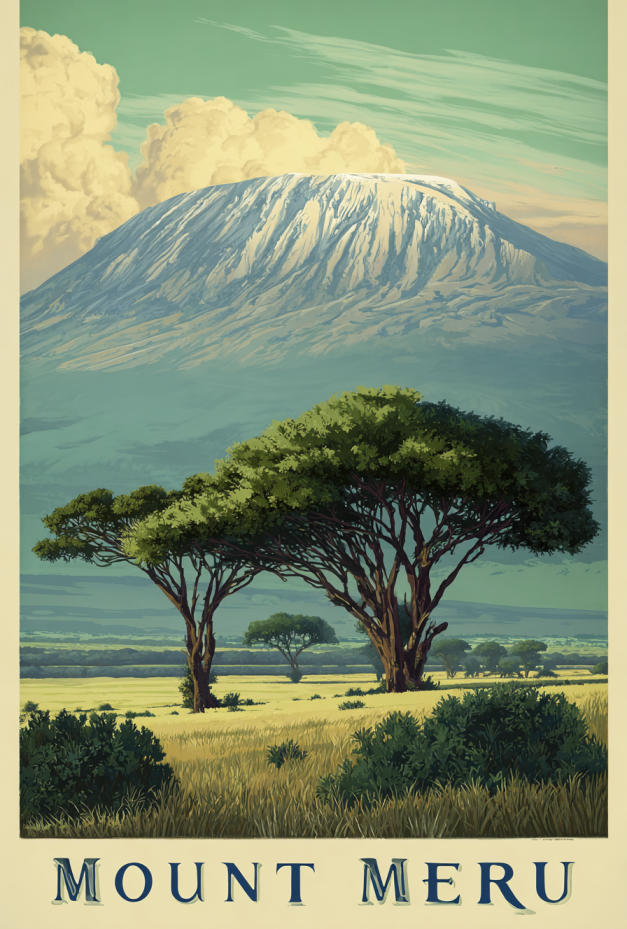Mount Meru is not a metaphor, nor a relic of forgotten cosmologies — it is the sacred heart of cosmic balance, a towering Divine Realm that rises beyond perception, anchoring the heavens and realms alike in symmetrical grace. Rooted in the essence of the Indus Valley and early Vedic spiritual systems, it stands not only as a seat of divinity, but as the still point around which the cosmos once turned. Meru is not fixed to any one plane but exists simultaneously across many, its peak brushing the skies of divinity while its roots spiral deep into the foundation of being. Here, elemental law and spiritual resonance meet, and the universe finds orientation.
Landscape and Essence
Mount Meru is immense beyond scale, a vast, many-sided peak of radiant gold, crystalline slopes, and glowing rivers that defy linear geometry. It does not resemble a mountain in mortal terms but instead unfolds like a mandala in motion — ever-rising, ever-revealing new layers of complexity and sacred symmetry. The air hums with the vibration of AUM, a soundless resonance that steadies reality itself. Its flanks are ringed by concentric ranges, elemental rings of fire, wind, water, and stone, each inhabited by distinct forces and laws. The summit is neither cold nor rarefied — it is clarity made form, where light manifests into thought and time becomes spacious. There is no nightfall here; instead, four suns orbit the spire, casting eternal, shifting light that mirrors the rhythms of consciousness.
Inhabitants
Meru is home to a luminous hierarchy of beings: devas, rishis, and elemental caretakers whose forms are braided from mantra and flame. Many appear anthropoid, robed in solar energy or crystalline armor, but form is only a courtesy to visiting souls — in truth, their essences resonate as concepts: strength, order, meditation, truth. Ancestors who achieved moksha may also dwell here, having relinquished individuality for roles in the mountain’s great alignment. At its base and intermediate ranges dwell the yaksha and gandharva — guardians of harmony and music — while the uppermost sanctum, Svarga, is the court of Dyaus-Pitar and his kin. There is no idle eternity here; all exist in sacred function, maintaining the wheel of cosmos through vibration, duty, and radiant joy.
Cultural Significance
In the Mortal Realm, echoes of Mount Meru found expression in countless cultures — as the world-mountain, the axis of reality, the pillar between earth and sky. In the Indus Valley and early Vedic traditions, it was not a symbol but a veiled memory, half-glimpsed in ritual and myth. Temples aligned to cardinal directions and mandalas drawn in sand were not decorative: they were maps to Meru’s structure, blueprints to remind mortals of their place in the greater lattice. Even as direct communion faded, Mount Meru remained the inner image of balance, ascension, and cosmic truth. The Veil’s descent did not erase it from belief — it merely sealed its paths, leaving only the echoes in geometry, chant, and the mountains that once mirrored its silhouette.
Role in the Divine Realm
Mount Meru serves as a metaphysical fulcrum — the point upon which celestial order pivots. It is not a throne or fortress, but an *engine of harmony*, constantly realigning the Divine Realm and its outlying domains into correct proportion. It is where elemental forces are balanced and where divine councils once convened to determine the arc of mortal evolution. Souls that reach Meru do not rest; they serve, becoming part of the living mechanism of sacred law and perception. As such, Meru is both temple and function — a place of highest reverence and deepest metaphysical necessity. Without it, reality would list, unravel, or splinter into disharmony.
Interactions with Other Realms
In ancient eras, Meru was visible — not in distance, but in knowing. Sacred groves, stepped temples, and isolated peaks served as thresholds, each mirroring a layer of the mountain. Pilgrims could dream their way up through mantras, or ascend in trance or flame. As the spiritual clarity of the Mortal Realm dimmed and external conquest disrupted internal harmony, these thresholds closed. The Veil did not fall suddenly, but thickened over generations, until no ritual could pierce it. Now, Meru exists beyond mortal reach, its resonance only faintly echoed in dreams, spirals, and chants that follow sacred proportion. Only those deities bound by Dharma — and certain perfected souls — may reach its gates.
















